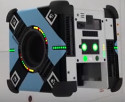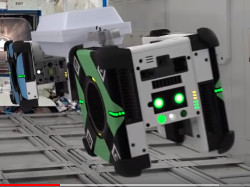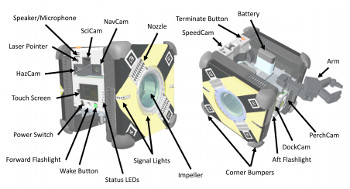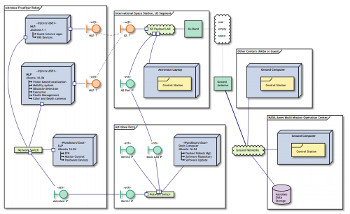Space Station welcomes free-flying, Ubuntu-powered autonomous robots
May 22, 2019 — by Eric Brown 3,378 views NASA has deployed three free-flying “Astrobee” robots on the ISS for house-keeping tasks. The bots run Ubuntu/ROS and Android 7.1 on Snapdragon-based Inforce modules and a Wandboard and feature 3x payload bays, 6x cameras, and a touchscreen.
NASA has deployed three free-flying “Astrobee” robots on the ISS for house-keeping tasks. The bots run Ubuntu/ROS and Android 7.1 on Snapdragon-based Inforce modules and a Wandboard and feature 3x payload bays, 6x cameras, and a touchscreen.
We haven’t heard a news from the IBM Watson connected CIMON social robot since it debuted with a truly strange video last December in which CIMON accused International Sopace Station astronaut Alexander Gerst of being “mean.” However, NASA has now deployed and tested three somewhat similar “Astrobee” robots on the ISS for assisting the astronauts rather than chatting them up.

Astrobee group portrait on ISS
(click image to enlarge)
Developed at NASA Ames Research Center, the Astrobee bots are named Honey, Queen and Bumble. They currently lack the AI skills, voice response, and facial recognition capabilities of CIMON, which was developed by the German space agency DLR along with Airbus and several European universities. However, they are similarly free-flying and driven by Ubuntu and offer autonomous or remote-controlled navigation.


Astrobee being tested by NASA astronaut Anne McClain (left) and two Astrobees transporting gear with their gripper arms
(click images to enlarge)
The Astrobee is roughly the same size as CIMON but is a cube rather than a modified sphere. The battery powered robot incorporates a touchscreen, 6x cameras, a speaker, a mic, flashlights, a laser pointer, and a variety of buttons, switches, and LEDs.
Three payload bays are available for running experiments through a modular add-on interface, and a gripper arm can be used to transport gear around the station. Like CIMON, the Astrobee uses electric fans to navigate through the zero-gravity ISS environment

Astrobee detail view
(click image to enlarge)
The chief job of the Astrobees is to let astronauts remotely monitor equipment via the bots’ cameras and mic while the they’re working elsewhere on the ISS. They can also perform inventory and do other housekeeping chores, or act as a general-purpose floating touchscreen computer. Although the robots should prove useful to the astronauts, their main purpose “is to provide a zero-gravity testbed for guest scientists to try out new robotic technologies in space,” stated Maria Bualat, Astrobee project manager at NASA Ames.


CIMON with Alexander Gerst (left) and Robonaut 2
The Astrobee is a more feature-rich alternative to the ISS’ MCU-based, free-flying SPHERES bots, which carry payloads on the station. The Astrobees are also inspired by earlier free-flying robotic cameras like the JAXA Intball and earlier PSA and AERCam Sprint.
— ADVERTISEMENT —
From a software point of view, the Astrobee is more like NASA’s humanoid Robonaut, which similarly runs a combination Ubuntu and Robot Operating System (ROS). While the Robonaut runs on PowerPC processors, the Astrobee uses three network-switched Arm-based computers running open source software. An Ubuntu/ROS stack runs on two of the computers while Android 7.1 runs on a third. There are also 7x MCUs on board for motor control.
At the highest application-facing level is a High Level Processor (HLP) based on Inforce’s Inforce 6601 Micro SoM module. The HLP runs Android 7.1 on the Snapdragon 820 SoC with 4x Cortex-A72 like Kryo cores. The HLP controls the touchscreen, speaker, mic, and SciCam. It’s responsible for running guest science applications developed by academics and commercial researchers.
There’s also a Mid Level Processor (MLP) that runs Ubuntu 16.04 and ROS on the Inforce 6501 Micro SoM, which incorporates Qualcomm’s earlier quad-core 2.7GHz Snapdragon 805. The SoC incorporates Cortex-A15-like Krait 450 cores.
The MLP is responsible for computationally intensive computer vision and mapping. It’s connected to two color imagers (NavCam and DockCam) and two depth imagers (HazCam and PerchCam). The PerchCam helps guide the Astrobee’s robotic arm, which it uses to stabilize itself and carry objects. The MLP offers features like vision-based localization, mobility, and obstacle detection, as well as controlling the fault management system and ground communications.

Astrobee hardware architecture
(click image to enlarge)
The Low Level Processor” (LLP) runs Ubuntu/ROS on Technexion’s open source Wandboard Dual SBC with an NXP i.MX6 SoC with 2x Cortex-A9 cores. The LLP runs the pose estimator and motion control loop and communicates with hardware components like the IMU and Power Manager. The LLC links up to another Wandboard Dual-based computer built into the Astrobee dock where the robots return for recharging.


Astrobee software architecture (left) and exposed view
(click images to enlarge)
The Astrobee Robot Software is written in C++ for its high-level constructs and ROS for its middleware. It also offers a Gazebo-based dynamic simulator with a number of custom plugins. More details may be found in the NASA Ames paper linked to below.
Further information
The Astrobees should complete testing and be available for full deployment by the end of the year. More information may be found in NASA’s Astrobee testing announcement and earlier overview, which has a nice YouTube video. To dig into the details, check out NASA Ames’ Astrobee research paper (PDF).

Thanks for the review! I didn’t know that free-floating space robots could be so interesting but this article drew me in. This is information-rich writing that includes plenty of background for the uninitiated like myself, and (despite the unavoidable alphabetti spaghetti of technical writing) the scrupulous defining of acronyms made this article easy to read and compelling, while the helpful links invite further exploration of the topic. I can’t comment on the technical details but I loved the article…Will recommend.